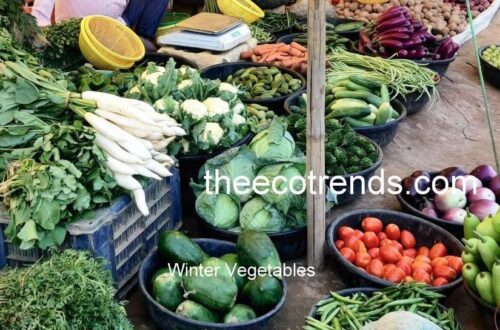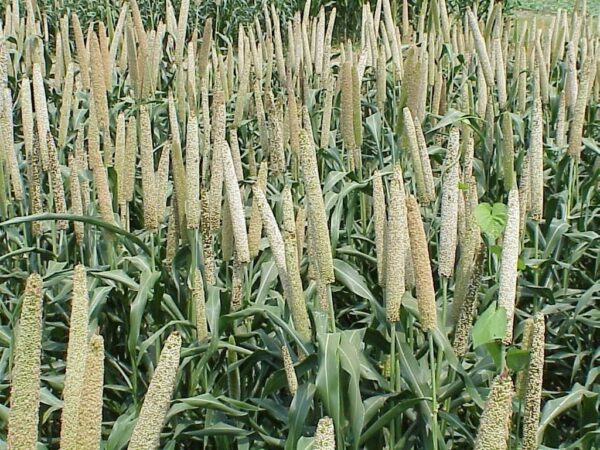Images of a number of vegetables start sliding one by one just as a slide show on the screen of the mind as we enter into the winter session of the yearly cycle. These vegetables are very important to us not alone for their taste value but for their medicinal and health value as well. Here is an introduction of two of these vegetables.
Radish
Radish is a root vegetable. It has root and foliage. However the stem emerges late when sufficient food is stored in the root and we do not pick it up off the ground. We uproot it when it stores sufficient food and becomes ready to be eaten up or to be used as vegetable.
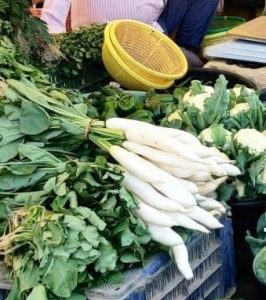
The dormant stem comes up through the middle of the whorl of leaves and grows up up to certain height. Later it bears inflorescence and fruits like that of the mustard plant.
In fact, the food stored in the root is used up in the growth of stem. The root becomes dried and hard. At this stage it is unfit to be eaten.
When we have to use the radish as vegetable, we do not allow the sufficient time to it to reach to the stem development stage and uproot it for use. When fruits are ripe and getting dry we collect seeds for further propagation of the plants.
Radish belongs to the taxonomic family Brassicaseae. Its scientific name is Raphanus sativus.
Different types of radish come in many varieties of shapes, sizes and colours. Radish can be eaten up raw as salad or can be mixed with other vegetables and cooked. Its leaves can also be cooked to make vegetable. Pickles of slices of radish are also made. Thus radish can be eaten in varieties of ways.
Health Values of Radish
1. Eating radish in proper amount can clear sinus cavities and can sooth our sore throat. It contains vitamin C and has also been reported to be anti-inflammatory. It contains Potassium and lowers the risk of kidney stones. It is good for brain also.
2. Radish contains fibres and it is helpful in managing weight. It has also been reported that radish helps reduce cholesterol level in blood. Thus it is good for our cardiac health also.
3. Being rich in fibre it is also helpful in regulating bowel movement. Thus it also eliminates constipation.
4. Radish also removes cough. It is good for skin as it contains vitamin B complex, vitamin c and zinc. It has also been reported to have low glycemic index. As such it is suitable for diabetics also.
5. Radish is good for healthy hair as it contains vitamin c, Folic Acid, Calcium, Potassium, and flavanoids.
Brinjal or the Night Shade Plant
Brinjal is a vegetable which is mainly grown during winter season. In today’s world it is available round the year. Depending on the climatic conditions it grows in other seasons also in other climatic zones of the world.
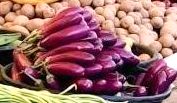
Here, in India one has to wait till winter for brinjal and also for some other winter vegetables. Now, most of the vegetables are being sold round the year.
Brinjal plant belongs to the taxonomic family Solanaceae. Its scientific name is Solanum melongena. It is tough, tropical, perennial plans. Some species have spiny stems and leaves. The leaves of this plant are broad and hairy and or spiny. Flowers are 5 lobed. Their colours range from white to purple. Stamens of flowers are yellow.
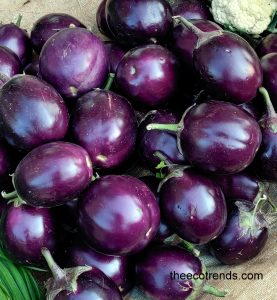
The fruit of Brinjal is botanically classified as berry. However the fruit may be big round to long. The colour of the fruit may also vary considerably. It contains numerous seeds.
Health Value of Brinjal Vegetable
Brinjal fruit is reported to contain nutrients like calcium (20%), carbohydrates (5%), Fibre (3%), Magnesium (9%), Folate (5%), Vitamin K (4%), Vitamin C (3%), and small amounts of niacin and copper.
Brinjal is reported to contain anti-oxidants. It reduces the risk of heart diseases. It may promote blood sugar control, and weight loss. It has cancer fighting abilities as well. It is reported to reduce LDL cholesterol and triglycerides.
Key Words : radish, brinjal, vegetable, winter

